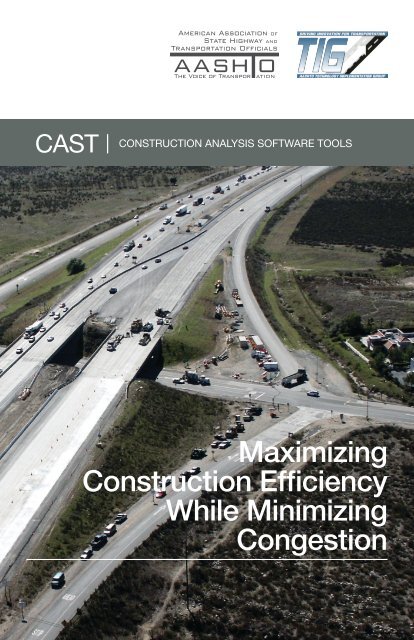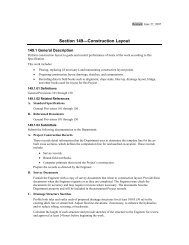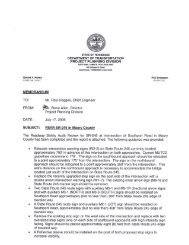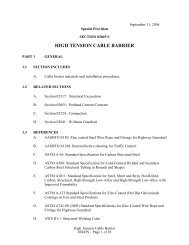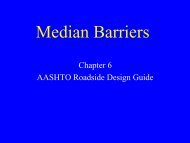TIG CAST (Jan 2008) - AASHTO Technology Implementation Group
TIG CAST (Jan 2008) - AASHTO Technology Implementation Group
TIG CAST (Jan 2008) - AASHTO Technology Implementation Group
Create successful ePaper yourself
Turn your PDF publications into a flip-book with our unique Google optimized e-Paper software.
<strong>CAST</strong><br />
Construction Analysis Software Tools<br />
Maximizing<br />
Construction Efficiency<br />
While Minimizing<br />
Congestion
<strong>CAST</strong> serves as an important weapon<br />
in today’s battles against declining<br />
budgets, increasing congestion,<br />
and aging infrastructure.<br />
2
Why <strong>CAST</strong><br />
Why Now<br />
<strong>CAST</strong> technology features<br />
software packages that<br />
provide managers and<br />
other decision-makers with<br />
information on construction<br />
options that minimize traffic<br />
congestion and maximize<br />
safe, efficient mobility during<br />
roadway construction or<br />
rehabilitation projects<br />
– and beyond.<br />
Using <strong>CAST</strong>, transportation<br />
agencies and their<br />
consultants can model various<br />
construction scenarios to<br />
determine which best serve<br />
the needs of all stakeholders.<br />
Although it is tempting to think<br />
of <strong>CAST</strong> as a gadget in an<br />
agency’s “toolbox” – it is more<br />
akin to a decision process<br />
through which various, key<br />
scenarios can be envisioned,<br />
“tested” and weighed<br />
against each other in terms<br />
of safety, cost, and impact<br />
on customers – as well as<br />
variables such as construction<br />
materials, methods, staging,<br />
and life-cycle costs.<br />
<strong>CAST</strong> also helps gather and<br />
organize data for Impacts<br />
Assessments and Traffic<br />
Management Plans required<br />
by FHWA’s Work Zone Safety<br />
and Mobility Rule for federalaid<br />
highway projects.<br />
One significant benefit of<br />
<strong>CAST</strong> technology is that it<br />
often produces a relatively<br />
clear map of the thought<br />
process involved in choosing<br />
key construction options. This<br />
makes it a useful component<br />
of public information efforts,<br />
providing stakeholders with<br />
a clear view of the factors<br />
involved in agency decisions<br />
that impact highway users.<br />
<strong>CAST</strong> offers agencies,<br />
industry, and customers a<br />
virtual opportunity to “try<br />
before they buy,” painting<br />
an accurate picture of<br />
how specific choices in<br />
the course of construction<br />
or rehabilitation are likely<br />
to perform in practice. In<br />
short, <strong>CAST</strong> helps agencies<br />
maximize the efficiency of<br />
the intricate construction<br />
planning, design, and<br />
implementation process.<br />
3<br />
<strong>CAST</strong> Maximizing Construction Efficiency While Minimizing Congestion
4<br />
What are my<br />
options<br />
Several popular software<br />
products are available in the<br />
marketplace to assist agencies<br />
with various aspects of<br />
construction analysis. Typical<br />
categories of options for these<br />
tools include:<br />
- traffic simulation and analysis<br />
- traffic management<br />
- construction scheduling and<br />
cost analysis<br />
- a combination of the<br />
above options.<br />
Traffic Simulations:<br />
These tools help evaluate the<br />
impact of a work zone on traffic<br />
at local or network levels. Three<br />
levels are available, depending on<br />
scope and complexity:<br />
• Microscopic (Based on<br />
individual vehicles and<br />
detailed characteristics like<br />
grade, curvature, car following<br />
and lane changing theories.<br />
Often focused on immediate<br />
construction area.)<br />
• Mesoscopic (Based on<br />
individual vehicles. Predicts<br />
at an aggregate level, using<br />
average speed on travel link.)<br />
• Macroscopic (Based on flow,<br />
speed, and density of broader<br />
traffic sectors; generally<br />
network, corridor, or<br />
region-wide.)<br />
Traffic Management Tools:<br />
These tools aid in the modeling of:<br />
• Traffic demand and handling<br />
• Optimal signalization<br />
• Analytical/deterministic<br />
factors (Usually yields basic<br />
level of service estimates<br />
regarding density, speed,<br />
and delay.)<br />
• Sketch planning (Produces<br />
general, often “first-cut,” travel<br />
demand and traffic operations<br />
estimates.)<br />
• Schedule estimation<br />
Construction Analysis Tools:<br />
These tools aid in the design of<br />
an effective construction plan by<br />
assisting in:<br />
• Stage planning<br />
• Construction scheduling<br />
• Cost analysis<br />
<strong>CAST</strong> products vary by vendor<br />
and can be used alone, in<br />
sequence, or in tandem<br />
with one another. Functional<br />
integration of various <strong>CAST</strong><br />
tools may be on the horizon,<br />
but at present, different tools<br />
are generally deployed for<br />
different needs or at different<br />
phases of the overall project.
How do I<br />
choose<br />
Typical <strong>CAST</strong> decision<br />
factors include:<br />
• Analysis Context<br />
(planning, design, or<br />
operations/construction)<br />
• Tool Category (sketch<br />
planning; deterministic/<br />
analytical; travel demand<br />
models; traffic signal<br />
optimization; micro, meso,<br />
or macroscopic simulation)<br />
• Most Appropriate<br />
Tool Within Category<br />
(comparison of vendor<br />
offerings, selection of the<br />
simplest tool that best<br />
meets need)<br />
Where can I<br />
learn more<br />
<strong>CAST</strong> is a focus technology<br />
of the American Association<br />
of State Highway Officials<br />
(<strong>AASHTO</strong>) <strong>Technology</strong><br />
<strong>Implementation</strong> <strong>Group</strong> – or<br />
<strong>TIG</strong>. More information,<br />
including experienced<br />
vendors, details from recent<br />
<strong>CAST</strong> workshops, and<br />
presentations by expert users<br />
and suppliers are available at<br />
www.aashtotig.org<br />
(click on <strong>CAST</strong>).<br />
<strong>CAST</strong> Maximizing Construction Efficiency While Minimizing Congestion<br />
5<br />
Photos courtesy of Barrier Systems
6<br />
Construction Analysis Software Tools<br />
Common Applications<br />
WORK ZONE TRAFFIC<br />
Construction Analysis<br />
Analysis Type Traffic Simulation Level Traffic Management<br />
Cost<br />
Analysis<br />
Stage<br />
Planning<br />
Impact of<br />
Signs<br />
Detour<br />
Planning<br />
User Delay<br />
Time/Cost<br />
Network<br />
Basis<br />
PRODUCT<br />
Scheduling<br />
Micro Meso Macro<br />
Local Basis<br />
AIMSUN ○ ○ ○ ○ ○ ○ ○ ○<br />
TransModeler ○ ○ ○ ○ ○ ○ ○ ○ ○<br />
Paramics ○ ○ ○ ○ ○ ○ ○<br />
CORSIM ○ ○ ○ ○ ○ ○<br />
IDAS ○ ○ ○ ○<br />
FREQ ○ ○ ○ ○ ○<br />
CA4PRS ○ ○ ○ ○ ○ ○<br />
Primavera N/A N/A ○ ○ ○
<strong>CAST</strong><br />
Construction Analysis Software Tools<br />
For additional <strong>CAST</strong> resources,<br />
visit www.aashtotig.org<br />
and click on <strong>CAST</strong>.<br />
7
About <strong>TIG</strong><br />
Dedicated to sharing high-payoff, market-ready technologies<br />
among transportation agencies across the United States,<br />
<strong>TIG</strong> promotes technological advancements in transportation,<br />
sponsors technology transfer efforts, and encourages<br />
implementation of those advancements.<br />
For more information visit<br />
www.aashtotig.org<br />
<strong>CAST</strong> Lead States Team<br />
<strong>TIG</strong>’s Lead States Team on Construction<br />
Analysis Software Tools includes DOT and<br />
FHWA representatives who can help you<br />
evaluate the use of the technology in your<br />
agency. Turn to team members for insight,<br />
expertise, and advice.<br />
California (Le a d St a t e )<br />
Michael Samadian, P.E.<br />
(916) 324-2048<br />
michael_m_samadian@dot.ca.gov<br />
Eul-Bum (E.B.) Lee<br />
(510) 665-3637<br />
eblee@berkeley.edu<br />
Bill Farnbach<br />
(916) 227-5845<br />
bill_farnbach@dot.ca.gov<br />
FHWA/He a d q u a r t e r s<br />
Jim Sorenson<br />
(202) 366-1333<br />
james.sorenson@fhwa.dot.gov<br />
FHWA/Tu r n e r Fa i r b a n k s Hi g hw a y<br />
Res e a r c h Ct r.<br />
Nadarajah Sivaneswaran<br />
(Siva), Ph.D., P.E.<br />
(202) 493-3147<br />
nadarajah.sivaneswaran@dot.gov<br />
Uta h<br />
Doug I. Anderson, P.E.<br />
(801) 965-4377<br />
dianderson@utah.gov<br />
Was h i n g t o n<br />
Linda M. Pierce<br />
(360) 709-5470<br />
piercel@wsdot.wa.gov<br />
Philip A. Fordyce, P.E.<br />
(425) 456-8590<br />
fordyce@wsdot.wa.gov<br />
Publication Date: <strong>Jan</strong>uary, <strong>2008</strong>


